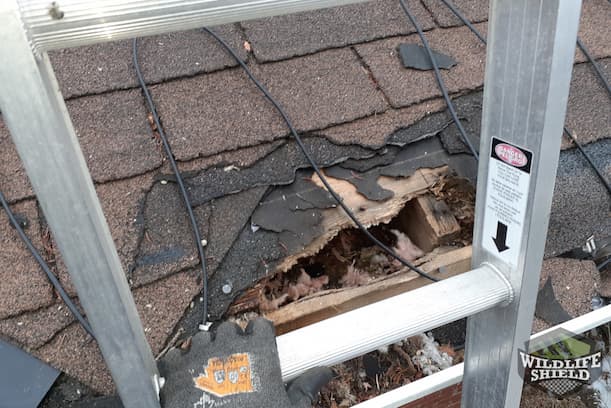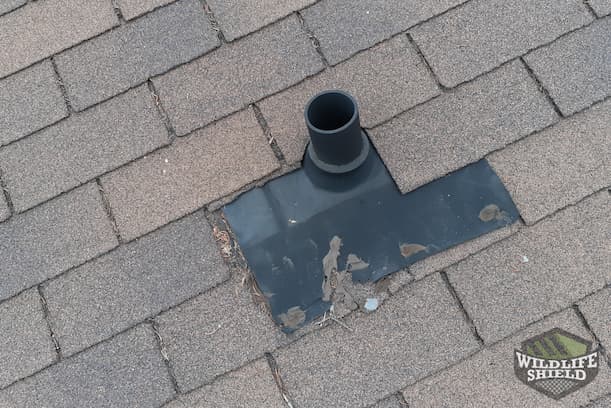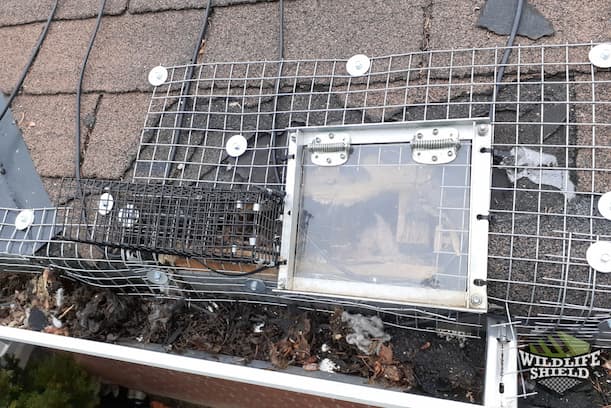The following case study details a squirrel and raccoon removal service in Brampton, Ontario. Both a squirrel and raccoon were living in the attic of a single-family home, having broken through the drip edge of the roof. To remove them safely, a member of the Squirrel Control team installed one-way doors and fully excluded the roof from another invasion. If there is wildlife in your area and you want to keep them out, contact Squirrel Control today: 647-496-0815.
Inspection
The homeowners of this Brampton property first reached out to Squirrel Control when they witnessed a lot of squirrel activity on their roof. They were concerned that the animals had made their way into the attic, so they wanted an inspection. Squirrel invasions are common in Brampton where there are many green spaces and parks for the animals to thrive. A technician visited the property the next day to investigate.
No matter the situation, our technicians always carry out detailed inspections so they can find out exactly what is going on. We check the area of concern as well as all the surrounding nooks and crannies to identify every potential weakness and contributing factor to the problem at hand. In this case, the technician found a large hole in the drip edge, signifying a raccoon issue. The shingles were torn, and the wooden framing was badly damaged.

Given the squirrel activity and the size of the hole in the roof, the technician on site believed that a raccoon made the hole, but that a squirrel was using it as well. Like squirrels, raccoons are attracted to attics for their warmth, height above ground, and safety from predators. It was also springtime when female squirrels and raccoons need a place to raise their young.
In addition to the hole, the technician on duty found a few vulnerabilities on the roof that could lead to another infestation. These included plastic roof vents, a plumbing vent, roof-soffit intersections, and several feet of weakened drip edge. Animals can exploit these areas to reach the attic inside and should therefore be sealed off to avoid another invasion.


To remove the animals humanely, the technician recommended having two one-way doors installed to the entry point. One door would be made specifically for the raccoon, while the other would be for the squirrel. To keep the animals from getting back in, it was also recommended that the roof’s edge be excluded with an impenetrable mesh. Moreover, the roof vents and soffits could also be protected with mesh. The homeowners agreed to have the one-way doors installed immediately and to have the surrounding roof edge excluded.
Removal and Exclusion
A total of 15 feet of roof edge were excluded with mesh. The material used was a galvanized steel mesh, which is weather-proof and strong enough to withstand the chewing and tearing of animals. While the technician could have excluded more, this part of the roof was especially damaged, and it is not uncommon for squirrels and raccoons to break their way back into the attic next to their previous entry point.

Once that was complete, the technician then installed the one-way doors. The door for the raccoon consisted of a plexiglass flap while the door for the squirrel was a mesh tube. The doors only swing outward, letting the animals out but blocking their return. The professionals at Squirrel Control use one-way doors to evict wildlife because they are highly effective and totally harmless.

Both the raccoon and squirrel were expected to leave within a few days or weeks. These are animals that need to leave their dens to find food. The homeowner was asked to continue listening and watching for signs of activity and to call if the infestation persisted. The technician would be back in a few weeks to remove the doors and replace them with mesh.
Conclusion
As expected, the squirrel and raccoon were gone within a few days. The homeowners stopped seeing animal activity on the roof and they could not hear anything coming from the attic. The animals exited their dens through the one-way doors and could not get back inside on the edge of the roof. The technician soon returned to the property, removed the doors, and replaced them with mesh to ensure that the animals could not use their entry points again.
This case demonstrates how suburban wildlife can work together and appear as a package. One pest often leads to another as entry points are made and the animals can smell each other’s presence. It is important that you maintain your attic and wildlife-proof its vulnerabilities to avoid this. Raccoons and squirrels are incredibly destructive animals that risk costing you hundreds or thousands in damages. If there are animals on your property, or if you want to keep them out, call Squirrel Control. We offer comprehensive wildlife solutions that are guaranteed and backed by a 2-year warranty.
